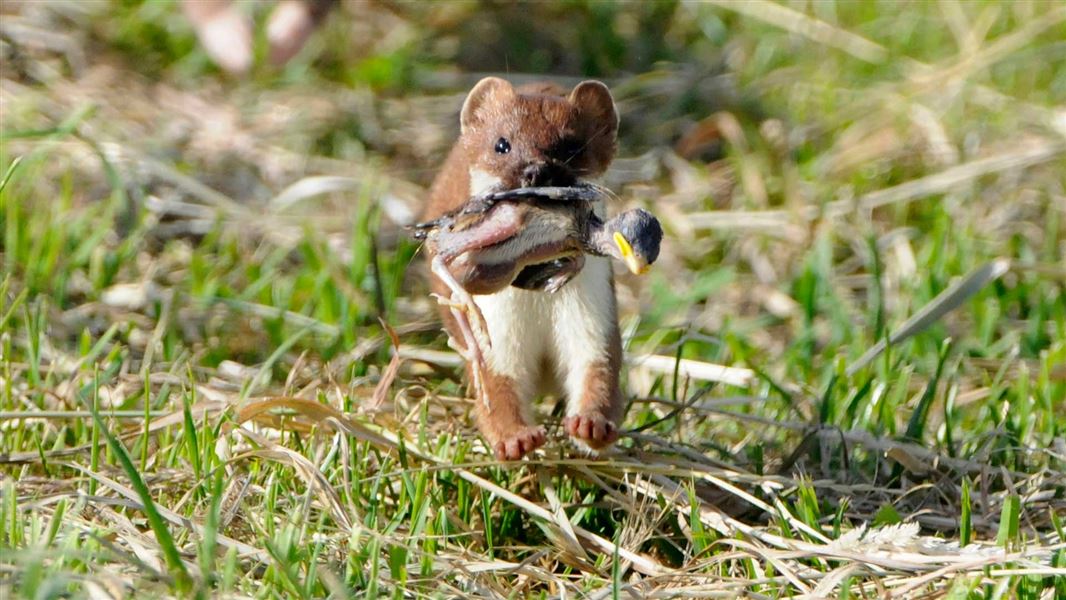Rats, stoats, possums, and other introduced predators kill an estimated 25 million native birds in New Zealand each year.
Habitat loss and introduced predators have caused more than 50 native bird species, along with several plants, frogs, reptiles, and bats, to become extinct.
Without predator control, many more native animal populations will become extinct in less than two human generations.
We face a choice: leave pests unchecked and accept that native forests will become silent and bare, or control these predators and help our native species to thrive.
1080 targets predators
New Zealand is unusual, because apart from bats, there are no native land mammals. This means we can control introduced mammalian predators without negatively impacting populations of native species.
1080 targets introduced predators such as rats and possums. Stoats are also controlled through scavenging of poisoned rat carcasses.
1080 protects native wildlife
When 1080 is used to control introduced predators, the populations of native birds, insects, plants, bats and frogs have a much better chance of survival.
Decades of monitoring and research have shown that conducting one aerial 1080 operation every 2–3 years, on average, can maintain predator numbers at a low level. This allows native species to survive, breed, and increase their populations. In some cases, more operations are necessary to protect highly endangered species or during periods of more frequent forest masts.
When introduced predators are effectively controlled there are proven benefits for entire ecosystems.
Learn more about the examples of success for our species at Proof that 1080 is protecting our species.
Did you know?
Only 5% of North Island brown kiwi chicks make it to breeding age without predator control. With effective predator control, which includes the use of 1080, 60% of the chicks can survive to breeding age when they are better able to fight off predators.
Learn more about the monitoring results for kiwis.
1080 is biodegradable
1080 breaks down rapidly in the environment and doesn't remain in the food chain. Microorganisms in the soil biodegrade or break down it, and it dilutes to harmless levels in waterways.
It also doesn’t build up in insects, aquatic life or plants, and it doesn’t damage the health-giving properties of plants or forests or make them unsafe.
How it breaks down
1. 1080 is rapidly diluted in water
It is almost always undetectable after 24 hours. Any uneaten bait pellets become soft from rain or dew. This allows 1080 to leach out into leaf litter and soil, where it is diluted further.
If there’s a lot of rain, 1080 dilutes rapidly to undetectable amounts in groundwater and streams. The amounts are so small that they have no toxic effects on land animals or aquatic wildlife.
2. Remaining traces are broken down in the soil
Any remaining traces of 1080 are broken down into non-toxic components by bacteria and fungi in the soil. Once 1080 has biodegraded, all that remains in the soil are natural compounds and minerals, including glycolate, fluoride and carbon, at levels that are normally found in the environment.
1080 is safe and practical
Many of New Zealand’s wild places are steep, inaccessible and covered in thick forest. Aerially applied 1080 bait is the only option in vast, remote or rugged areas.
Trapping in these areas is impossible because of the number of traps needed and the trap lines that would have to be cut, walked regularly and maintained.
1080 can be applied safely and accurately by helicopters over large forests areas so that good coverage is achieved. We aim for complete coverage of selected treatment areas to prevent pockets of pest populations from surviving and repopulating the surrounding areas.
Did you know?
In 2011, the independent Parliamentary Commissioner for the Environment conducted a review of the use of 1080. The report assessed 1080 for its effectiveness, safety and humaneness and found that not only should we continue to use 1080 to protect our forests, but we should use more of it.
1080 protects against predator plagues
Predator populations can irrupt in years when the climate causes trees to produce large amounts of fruit and seeds across the country. These are called mast years.
Predator plague events severely increase the risk to native species, and widespread predator control is needed to protect them. In these mast years, rats can have litters of up to 14 pups, five times a year.
In the past, uncontrolled mast events have led to local extinctions of some native birds.
Aerially applied 1080 bait is the only method that can effectively protect native wildlife from predators during these events.
Visit Predicting forest mast events for more information.
1080 is backed by science
The use of 1080 is supported through research by independent scientists and other experts.
The Environmental Protection Authority has approved the use of 1080 as a tool for predator control in New Zealand. All 1080 predator control operations must have permission from the Ministry of Health. DOC consults and/or partners with the relevant rūnanga, hapū and/or iwi for each operation.
Many conservation groups and organisations endorse the use of 1080, including Forest & Bird, Federated Farmers, OSPRI, the World Wildlife Foundation (WWF), the Environmental Protection Authority and the Ministry of Health.
There is also widespread support from community conservation groups because 1080 operations bolster their efforts to protect native species through the use of bait stations and trapping networks.
More information
For more information visit Research and references or read our 1080 as a tool for predator control FAQ (PDF, 1,369K)
